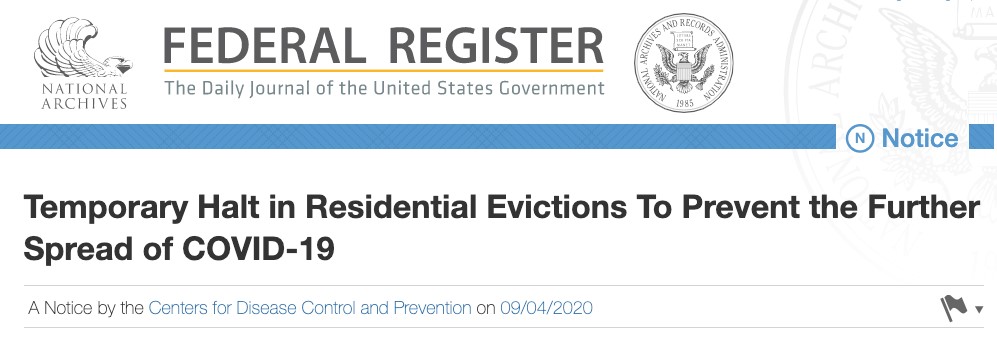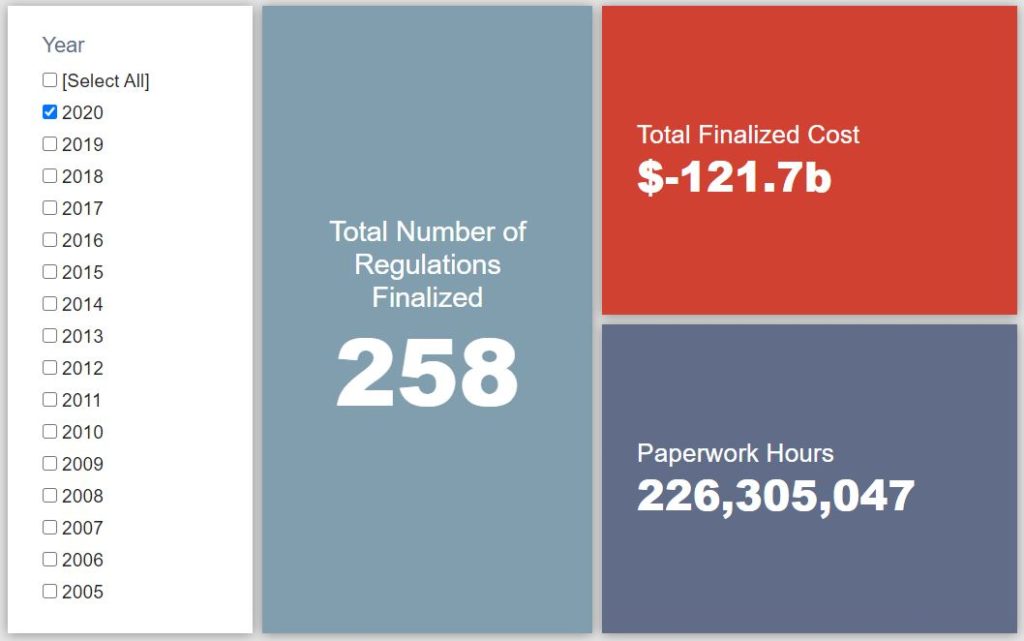Week in Regulation
September 8, 2020
Major COVID-19 Rule Leads Busy Week
Last week was a busy one in the pages of the Federal Register. The American Action Forum (AAF) recorded 20 rulemakings that had some measurable economic impact estimates. One Department of Health & Human Services (HHS) rule, focusing on COVID-19 reporting requirements in long-term care facilities, stood out far and away from the others, however, due largely to some eye-popping administrative burdens. Across all rulemakings, agencies published $4.6 billion in total net costs and added more than 93.5 million hours of annual paperwork.
REGULATORY TOPLINES
- Proposed Rules: 39
- Final Rules: 69
- 2020 Total Pages: 55,285
- 2020 Final Rule Costs: -$121.7 billion
- 2020 Proposed Rule Costs: $8.2 billion
TRACKING THE REGULATORY BUDGET
The most significant rulemaking of the week was the HHS interim final rule regarding “Additional Policy and Regulatory Revisions in Response to the COVID-19 Public Health Emergency.” Given its interim status, it does not officially count toward the fiscal year (FY) 2020 regulatory budget. HHS states that the rule’s regulatory budget impact “will be informed by public comments received.” Nevertheless, according to HHS’s estimates, it could yield roughly $4.5 billion in new costs due largely to roughly 93.3 million hours of paperwork.
The sizable nature of these figures stems from the extensive testing requirements that the rule establishes. In particular, HHS estimates that it will take affected entities 231,072 hours to collect COVID-19 test results and another 231,072 hours to report said results per day. Further on in the rule, HHS expects such entities to test for 200 days in a year given the following formula: “365 days/year−104 weekend days−10 federal holidays−approximately 50 days to account for laboratories who do not test 7 days/week.” Factoring this testing volume in means that the annual administrative burdens balloon to roughly $4.3 billion with an additional $176.5 million in upfront costs.
The Trump Administration expected to reach $51.6 billion in cumulative net savings in FY 2020. To date in the fiscal year, agencies have officially published 123 deregulatory actions and 44 regulatory actions, totaling $171 billion in quantified total net cost savings.
THIS WEEK’S REGULATORY PICTURE
This week, the Centers for Disease Control and Prevention (CDC) orders a halt to evictions to prevent the spread of COVID-19.

Source: https://www.federalregister.gov/documents/2021/02/03/2021-02243/temporary-halt-in-residential-evictions-to-prevent-the-further-spread-of-covid-19
On September 4, CDC published an order in the Federal Register that temporarily blocks evictions of most tenants through at least December 31. The order stems from an August executive order that directed agencies to examine how they could take steps to help renters who, due to the COVID-19 pandemic and the economic damage it caused, are at increased risk of eviction.
As AAF’s Thomas Wade explains, the order expands on the eviction moratorium passed in the Coronavirus Aid, Relief, and Economic Security (CARES) Act that expired in July. While the moratorium in the CARES Act only applied to federally subsidized housing or properties on a federally backed mortgage, the CDC order applies to any type of rental property. The only limits on who is protected by the order are income-based. Essentially, if a tenant received a payment from the CARES Act, they are eligible for protection.
From a regulatory-policy perspective, the order presents an interesting case. CDC relies on broad authority that allows the CDC director to intervene when “measures taken by health authorities of any State or possession (including political subdivisions thereof) are insufficient to prevent the spread of any of the communicable diseases from such State or possession to any other State or possession.”
In this case, however, rather than target states and territories that have failed to adequately contain the virus, CDC is issuing a blanket order nationwide (although it excludes American Samoa). It could set a precedent that leads to future federal mandates. Some have speculated, for example, that under CDC’s reasoning for action in this situation, they could try to issue a nationwide mask mandate. Where the line is drawn on the federal government’s ability to intervene on matters like this will ultimately be decided by the courts.
TOTAL BURDENS
Since January 1, the federal government has published $113.5 billion in total net cost savings (with $121.7 billion from finalized rules) and 246 million hours of net annual paperwork burden increases (with 226.3 million hours due to final rules). Click here for the latest Reg Rodeo findings.












